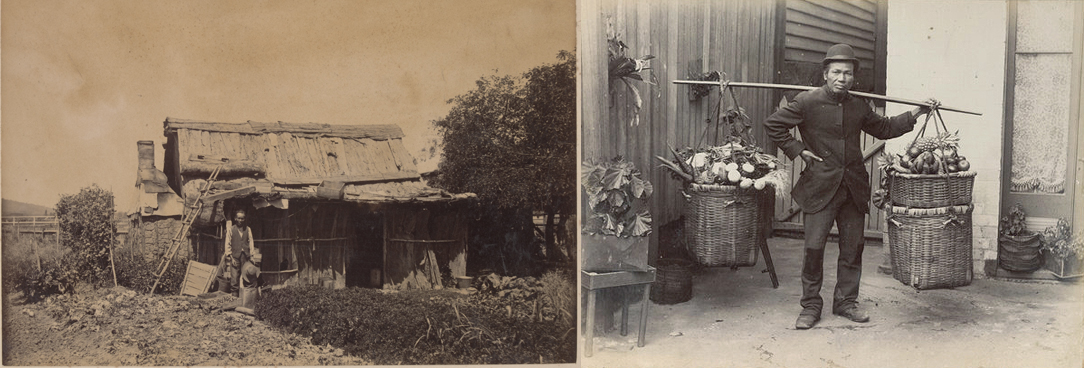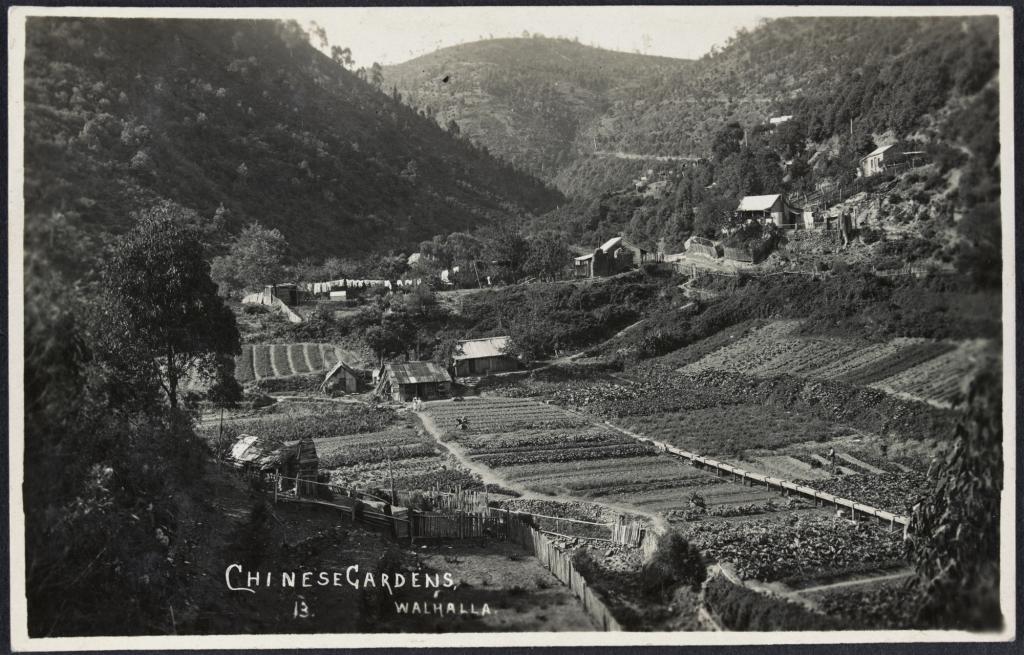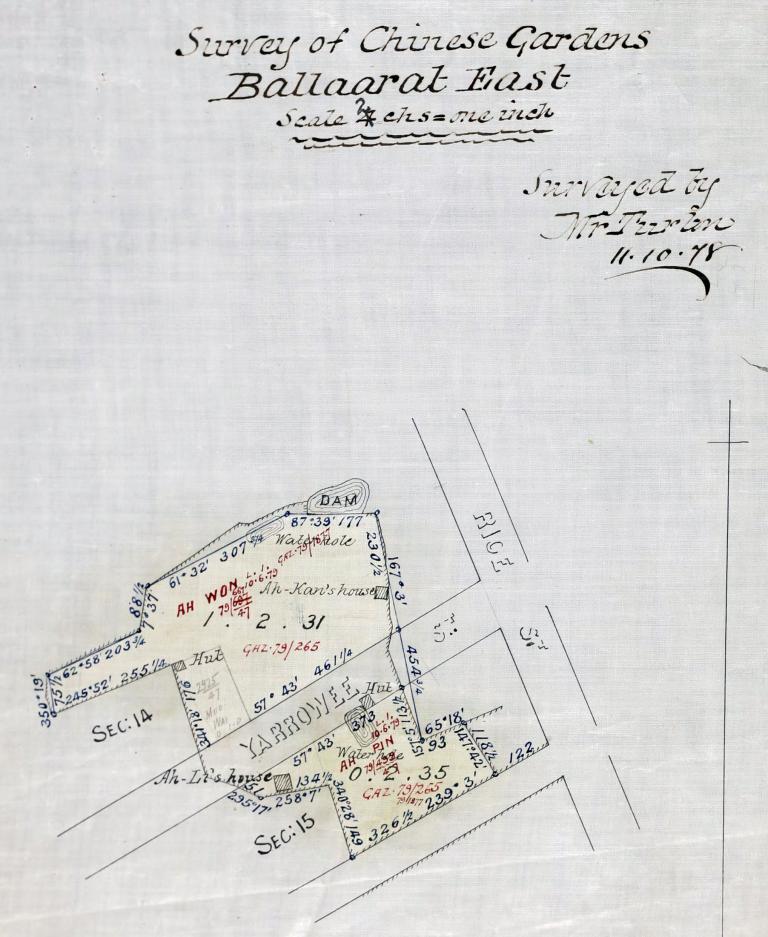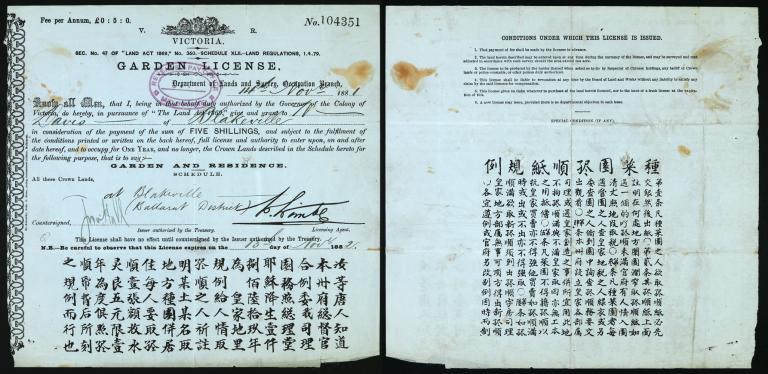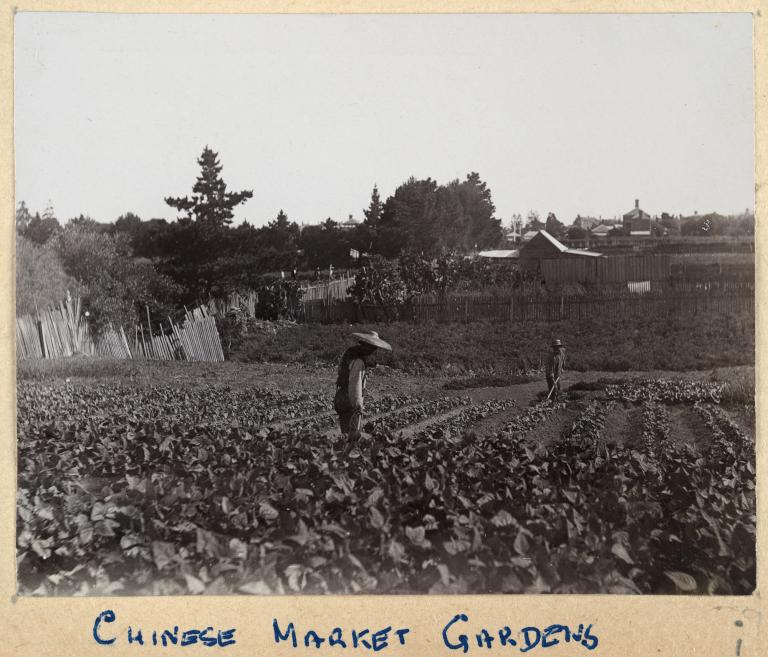
Author: Natasha Cantwell
Communications & Public Programming Officer
Our state and national archives hold many collections of records from the nineteenth century. Maps, articles, photographs and official documents reveal fascinating details about the diverse groups of people who contributed to the Colony of Victoria. Among them were the settlers from China, who worked tirelessly to turn seemingly desolate patches of land into bountiful gardens, providing the colony with much-needed fresh produce. The below article delves into the history of Victoria’s market gardeners, utilising primary resources from Public Record Office Victoria, State Library Victoria and the National Library of Australia.
While there were already a small number of Chinese merchants and labourers living in Victoria before the 1850s, it was the discovery of gold that saw a sudden increase in immigrants from China, particularly from the impoverished communities in Southern China, which were being ravaged by civil war. The Taiping Rebellion (1850 - 1864) was having a devastating effect on the local farms and villages, so when news arrived of gold in Australia, a land being touted as peaceful and abundant, thousands seized the opportunity to break free from poverty and try their luck as a miner.
Often they would need to borrow money from a merchant for the fare to Australia and then have to work off the debt. However, once it was repaid, they were free to start their own operations, and would commonly form cooperative partnerships with two to ten people they knew from their village, allocating each member a separate duty. These tasks did not just include mining work. Domestic chores, such as cooking, gardening and laundry were given equal importance. This communal approach not only helped the miners within the group to improve their productivity, but also ensured, that with dedicated gardeners, they had flourishing crops all year round.
Many of the gardeners came from agricultural backgrounds and they were quickly able to adapt to the new environment by drawing on knowledge that had been handed down through generations. Using traditional hand-made tools and labour-intensive methods, including crop rotation and double cropping, they worked long hours to get the maximum yield possible from land that was often deemed too difficult to cultivate by the European settlers. According to the Bendigo Advertiser in 1862,
“For the most part, the plots of land, made fertile by indomitable patience and unremitting attention, are situated in the very midst of old gold-workings. In few cases has dame nature aided the Chinese. Black or chocolate soil has been far from their holdings. Stiff clay and quartz pebbles have for the most part called them lords.” 1
It was not long before the horticulture skills of the Chinese gardeners became known throughout the colony and hawkers bringing their produce into the townships became a welcome sight. Early each morning, whether rain or shine, they would travel door to door with large baskets filled with a range of European and Chinese vegetables. Their regularity was regarded as impressive, as was the dedication and work ethic of the men tending the vegetable patches. In an article from The Australian News for Home Readers in 1865, the author observed that,
“No trifle is considered beneath notice, and a gentler and more careful cultivator than the Chinese gardener it would be difficult to imagine. He seems to be passionately fond of his plants, and nurses them most affectionately. For a picture of patience, nothing could surpass a Chinese gardener washing blight from the blades of his cabbage. With a keg of soapy water, and a piece of stick with a rag tied to the end of it, he moves slowly along the side of the plot, tenderly lays hold of one blade after another, and carefully rubs off the blight with the cloth after he has dipped it in the water. To wash many hundreds of cabbages in this fashion, seems an extraordinary undertaking, but the Chinaman thinks it the most natural thing in the world, and, persistently persevering, it is astonishing.” 2
As mining prospects began to wane in the late 1860s and 1870s, market gardening took over as the most popular occupation for Chinese people in Victoria. It was so popular in fact, that Victoria’s official Garden Licence, issued by the Department of Lands and Survey, was written in both English and Chinese.
The cooperative system that worked so well for the Chinese mining groups was also utilised for these new market garden enterprises, which often comprised of around four to six men. Each had an equal interest in the business, but a different duty to perform, such as sowing seeds, weeding, watering, preparing plots or selling the produce. In 1865, The Australian News for Home Readers wrote,
“These arrangements once made are rigidly adhered to, and are universally carried out in the most amicable spirit. In this respect they set an example worthy of imitation by many Europeans. There is never any wrangling or jealousy among them, and one is not to be found complaining that he has too much work to perform, and that his partners do less than him.” 3
But despite the fact that many European settlers admired their skills and work ethic, Chinese people in Victoria still often had to deal with hostile attitudes from neighbours, the media and the government. They endured anti-Chinese demonstrations, racist cartoons in the newspapers and a constant threat of violence and bullying. Chinese immigrants also had to pay a £10 poll tax on arrival to Victoria, as well as an annual residency tax at least four times higher than everyone else. In addition, the Chinese gardeners faced resentment from European gardeners, who felt unable to compete. Local groups would often band together to lobby the government to increase taxes to their Chinese counterparts or ban them from selling door to door. They tried to incite the community to boycott Chinese produce by spreading rumours that their gardens were unhygienic, or their vegetables not fresh. However these attempts were generally unsuccessful, as most people had come to rely on their quality, cheap and convenient produce. In 1887, a writer for The Alexandra Standard speculated that,
“If city residents had to depend upon European hawkers for their supply of vegetables, the cost would be something enormous. Vegetables, in fact, would become so great a luxury as to be beyond the reach of the poor man.” 4
After the gold rushes, the number of Chinese leaving Victoria steadily became greater than those who were arriving. The constant battle against being treated as second-class citizens made it hard for many Chinese settlers to feel at home in Victoria. Many also had families back in China and were keen to return once they had made some money. However, there were still gardeners who persevered, working on into their old age. These hardworking men, although elderly and frail, could still be seen in the early to mid twentieth century, pushing their produce to Victoria Market every market day.
If you are interested in finding out more about Chinese settlers in nineteenth century Victoria, the following articles in Provenance Journal provide insights into the lives of everyday people, from miners through to entrepreneurs:
‘Mud, Sludge and Town Water: Civic Action in Creswick’s Chinatown’ by Elizabeth Denny.
1. “Chinese Gardens” (1862, July 22). Bendigo Advertiser (page 2). Retrieved from: https://trove.nla.gov.au/newspaper/article/87901221
2 & 3. “Chinese Gardening” (1865, March 25). The Australian News for Home Readers (pages 4 - 5). Retrieved from: https://trove.nla.gov.au/newspaper/article/63169590
4. “Agricultural Notes” (1887, September 16). The Alexandra Standard (page 5). Retrieved from: https://trove.nla.gov.au/newspaper/article/57170755
Material in the Public Record Office Victoria archival collection contains words and descriptions that reflect attitudes and government policies at different times which may be insensitive and upsetting
Aboriginal and Torres Strait Islander Peoples should be aware the collection and website may contain images, voices and names of deceased persons.
PROV provides advice to researchers wishing to access, publish or re-use records about Aboriginal Peoples
